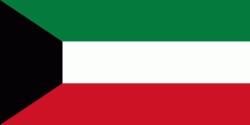Salmiya (As Sālimīyah)
Salmiya (Arabic السالمية; transliterated As-Sālmīya(h)) is a city in Hawalli Governorate in Kuwait.
Salmiya is administratively divided into 12 blocks. The blocks located closer to the interior of the district tend to be mostly residential, while those located beside the Persian Gulf coastline have a great deal of commercial and up-scale residential real estate. The interior residential areas boast a huge population of foreigners consisting mainly of those from the Indian sub-continent and other Arabs who are not native to the Persian Gulf area.
Salmiya hosts numerous museums, mosques, an aquarium, a Scientific Center, IMAX movie theaters, football stadium, medical centers, a Roman Catholic Chapel, the district passport office ("Jawazat") and a well-equipped park beside the 5th Ring Road. Notable malls include the Salmiya Souq Mega-mall which was the first mall in the nation, Marina Mall in the Marina World shopping and entertainment district, and the Omariya mall. The Gulf Road is coveted for its amazing sea vistas and is the main hub for new construction of future buildings and renovations. A boulevard passing through much of coastal Salmiya is a reflection of Kuwait's drive to modernity.
The Salem Al-Mubarak Street shopping district, commonly known as Salmiya Center, runs down the outer blocks of Salmiya. It is one of the oldest and largest shopping districts of Kuwait. It is a remnant of Kuwait's once numerous traditional souk bazaars, similar to the ones located in Jleeb Al-Shuyoukh and the centre Kuwait City. Well known in the past for pearls, gold and jewellery, it now consists of a wide array of retail giants and local outlets. Much of the old souk had been built over, but the feel and atmosphere of the past albeit remains visible at the traditional precincts of this shopping district. The experience varies from modernized (and Westernized) in the strip malls, to a true Kuwaiti experience on some of the back streets. It is notable to point out that the more eastward away from the capital one moves along the strip, the fancier and pricier the shops are in general. There are many gold and fabric shops in the "Old Souk" area located onwards from the intersection of the 4th Ring Road and the strip.
Salmiya is administratively divided into 12 blocks. The blocks located closer to the interior of the district tend to be mostly residential, while those located beside the Persian Gulf coastline have a great deal of commercial and up-scale residential real estate. The interior residential areas boast a huge population of foreigners consisting mainly of those from the Indian sub-continent and other Arabs who are not native to the Persian Gulf area.
Salmiya hosts numerous museums, mosques, an aquarium, a Scientific Center, IMAX movie theaters, football stadium, medical centers, a Roman Catholic Chapel, the district passport office ("Jawazat") and a well-equipped park beside the 5th Ring Road. Notable malls include the Salmiya Souq Mega-mall which was the first mall in the nation, Marina Mall in the Marina World shopping and entertainment district, and the Omariya mall. The Gulf Road is coveted for its amazing sea vistas and is the main hub for new construction of future buildings and renovations. A boulevard passing through much of coastal Salmiya is a reflection of Kuwait's drive to modernity.
The Salem Al-Mubarak Street shopping district, commonly known as Salmiya Center, runs down the outer blocks of Salmiya. It is one of the oldest and largest shopping districts of Kuwait. It is a remnant of Kuwait's once numerous traditional souk bazaars, similar to the ones located in Jleeb Al-Shuyoukh and the centre Kuwait City. Well known in the past for pearls, gold and jewellery, it now consists of a wide array of retail giants and local outlets. Much of the old souk had been built over, but the feel and atmosphere of the past albeit remains visible at the traditional precincts of this shopping district. The experience varies from modernized (and Westernized) in the strip malls, to a true Kuwaiti experience on some of the back streets. It is notable to point out that the more eastward away from the capital one moves along the strip, the fancier and pricier the shops are in general. There are many gold and fabric shops in the "Old Souk" area located onwards from the intersection of the 4th Ring Road and the strip.
Map - Salmiya (As Sālimīyah)
Map
Country - Kuwait
 |
 |
| Flag of Kuwait | |
Historically, most of present-day Kuwait was part of ancient Mesopotamia. Pre-oil Kuwait was a strategic trade port between Mesopotamia, Persia and India. Oil reserves were discovered in commercial quantities in 1938. In 1946, crude oil was exported for the first time. From 1946 to 1982, the country underwent large-scale modernization, largely based on income from oil production. In the 1980s, Kuwait experienced a period of geopolitical instability and an economic crisis following the stock market crash. In 1990, after oil production disputes with neighbouring Iraq, Kuwait was invaded, and later annexed into one of Iraq's governorates by Iraq under Saddam Hussein. The Iraqi occupation of Kuwait came to an end on February 26, 1991, after military intervention by a military coalition led by the United States and various other countries.
Currency / Language
| ISO | Currency | Symbol | Significant figures |
|---|---|---|---|
| KWD | Kuwaiti dinar | دك | 3 |
| ISO | Language |
|---|---|
| AR | Arabic language |
| EN | English language |















